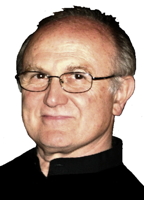
|
The Society of Folk Dance Historians (SFDH) Kálmán Magyar
[
Home |
About |
Encyclopedia | CLICK IMAGE TO ENLARGE |

|
BACKGROUND
Information: Kálmán Magyar, teacher of Hungarian dance.
Kálmán was born in Kiskunhalas, Hungary, and started his dance training at the age of nine. A year later he was accepted at the Hungarian Ballet Institute where he received his formal training that included folk dancing.
In 1962, he arrived in the United States and shortly thereafter became the artistic director of the Hungaria Folk Ensemble in New York City, a job he held until 1996. The group presented and preserved Hungarian folk culture in America.
In 1976, Kálmán became the director of the American Hungarian Folklore Centrum, a division of the American Hungarian Educator's Association (AHEA), and in 1990 became vice president. There he organized cultural programs for the scholarly and public life of North America.
Kálmán received a Master of Business Administration at the Fairleigh Dickinson University Master and a Bachelor of Science at Long Island University.
Kálmán started Hungaria Records (HR) in the 1970s. It is still a viable entity and still very much a family affair. Since that time, HR has released several new CDs that are available through www.cdbaby.com. HR still has some of the old records and tapes and has a good selection of CDs from Hungary for the discriminating aficionado.
In recent years he has taught at major camps and workshops throughout the United States and Canada, has choreographed for many folk dance ensembles, has organized and directed Pontozo (the Hungarian Folk Dance Competition), and regularly teaches Hungarian character and style classes in New York City.
Since 1982, Kálmán has been director of American Hungarian Folklore Centrum (AHFC). Centrum Management organizes professional tours for Hungarian performing ensembles in North America. In 1985, Kalman became the director of the Hungarian Museum in Passaic, New Jersey, which he collects, cultivates, and presents Hungarian culture in one of the largest Hungarian communities in the United States. In 1988, he became vice president of the Hungarian Library and Historical Society, in New York City, New York. The library is involved in the collection and preservation of Hungarian history and literature in America.
In the 1970s, he received awards from the Hungarian World Federation and the Hungarian Organization in the New York area, and was a recipient of the Budapest "National Flag Award." Kálmán received recognition by the Hungarian Community of Friends in 1998 and the Republic of Hungary's Award of Recognition Cross in 2000.
Kálmán's wife, Judith Magyar, was born in Budapest, Hungary, and received most of her formal education there. She arrived in the United States in 1963, and here received her degree in interior decoration.
In 1968, she joined the Hungaria Folk Ensemble in New York City and became costume director of the group as well as a dancer.
Kálmán and Judith met through folk dancing and have been married since 1969. Their mutual interest in folk dancing makes their lives harmonious and very active. They continue to research Hungarian folklore both here in the United States and in Hungary.
Judith has taught at major camps and workshops throughout the United States and Canada and is a choreographer. She also taught folklore and dance at the Hungarian School of the Hungarian Reformed Church in Passaic, New Jersey, and published and edited KAÁRIKÁZO, a Hungarian Folklore Journal. In addition to these talents, Judith leads sessions in Hungarian folk songs, plays the Hungarian zither, and does beautiful Hungarian embroidery.
Kálmán and Judith live in Teaneck, New Jersey.
Dances Kálmán and Judith have taught include Dudálás, Dunántuli Ugrós, Friss Magyar Csárdás, Gömöri Csárdás, Gömöri Friss Csárdás, Jöjj Által, Körtánc, Lörincrévi Csárdás, Lörincrévi Lassú Csárdás, Lörincrévi Szapora, Nagyecscedi Csárdás, Ne Félj Lányom, Rábaközi Csárdás, Rábaközi Dus, Páros és Csillag, Rábaközi Csárdás, Sárköozi Karikázó, Somogyi Kánasztánc, Szakácsné Tánc, Szatmári Cycle, Székely Verbunk, Szennai Karikázó, Szenyi Körverbunk, Várba Harangoznak, Vasvári Verbunk, Zőld Fű, and several improvisational dances from Hungary and Transylvania.
This page © 2018 by Ron Houston.
Please do not copy any part of this page without including this copyright notice.
Please do not copy small portions out of context.
Please do not copy large portions without permission from Ron Houston.